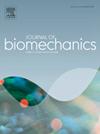Parametric cushioning lattice insole based on finite element method and machine learning: A preliminary computational analysis
IF 2.4
3区 医学
Q3 BIOPHYSICS
引用次数: 0
Abstract
The cushioning performance of insole has always been a critical consideration in its design. While the development of intelligent methods and the emergence of additive manufacturing (AM) technology have enhanced design freedom and convenience, a standardized approach to guide designers in selecting optimal materials and structures for specific scenarios is still lacking. This study aims to propose a controllable parameterized lattice cushioning insole (PLI) by integrating finite element (FE) and machine learning (ML) methods. The insole performance can be adjusted by modifying the structural parameters (a, b) and the internal strut thickness (t). The findings indicate that PLI, under the optimal parameter combination (a = 2.54, b = 3.56, t = 3.15), can reduce plantar pressure by up to 44.45 %, which may be achieved by increasing the contact between the footwear and the foot. The data-driven PLI optimization design method proposed in this study significantly enhances the cushioning performance of insole structures, simplifies the optimization process for selecting insole structures or materials, and provides a systematic and efficient solution for insole design. Although the initial preparation of material data is time-intensive, the trained model eliminates the need for repeated laboratory gait analysis or plantar pressure measurements, offering a foundational reference for clinical applications in insole structure design.
求助全文
约1分钟内获得全文
求助全文
来源期刊

Journal of biomechanics
生物-工程:生物医学
CiteScore
5.10
自引率
4.20%
发文量
345
审稿时长
1 months
期刊介绍:
The Journal of Biomechanics publishes reports of original and substantial findings using the principles of mechanics to explore biological problems. Analytical, as well as experimental papers may be submitted, and the journal accepts original articles, surveys and perspective articles (usually by Editorial invitation only), book reviews and letters to the Editor. The criteria for acceptance of manuscripts include excellence, novelty, significance, clarity, conciseness and interest to the readership.
Papers published in the journal may cover a wide range of topics in biomechanics, including, but not limited to:
-Fundamental Topics - Biomechanics of the musculoskeletal, cardiovascular, and respiratory systems, mechanics of hard and soft tissues, biofluid mechanics, mechanics of prostheses and implant-tissue interfaces, mechanics of cells.
-Cardiovascular and Respiratory Biomechanics - Mechanics of blood-flow, air-flow, mechanics of the soft tissues, flow-tissue or flow-prosthesis interactions.
-Cell Biomechanics - Biomechanic analyses of cells, membranes and sub-cellular structures; the relationship of the mechanical environment to cell and tissue response.
-Dental Biomechanics - Design and analysis of dental tissues and prostheses, mechanics of chewing.
-Functional Tissue Engineering - The role of biomechanical factors in engineered tissue replacements and regenerative medicine.
-Injury Biomechanics - Mechanics of impact and trauma, dynamics of man-machine interaction.
-Molecular Biomechanics - Mechanical analyses of biomolecules.
-Orthopedic Biomechanics - Mechanics of fracture and fracture fixation, mechanics of implants and implant fixation, mechanics of bones and joints, wear of natural and artificial joints.
-Rehabilitation Biomechanics - Analyses of gait, mechanics of prosthetics and orthotics.
-Sports Biomechanics - Mechanical analyses of sports performance.
 求助内容:
求助内容: 应助结果提醒方式:
应助结果提醒方式:


